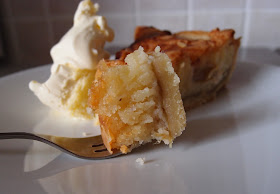The rainy April and early May has been excellent for garden
rhubarb but, now the hot weather has arrived it will rapidly dry out and become
straw-like. Before that happens, I’ve
just managed to sneak in one more rhubarb recipe!
This tart has a shortbread base which is very buttery, very
short and very crumbly. It tastes just
like the lightest shortbread biscuit you’ve ever eaten but is soft and tricky
to work with, although it does patch well.
The original recipe I adapted said you should bake it blind, as you
would pastry i.e. baking paper and beans.
I did this and, after baking, when I lifted the paper out, most of the
shortbread went with it! After laughing
at how amusing this was (yeah, right) I found myself scraping soft shortbread
off the paper and spreading it back into the tin – just about saving it. What I’m trying to say is – don’t line the
baking paper with beans. Unless you want
heartbreak!
The creamy mascarpone filling is light and creamy. I will definitely use it for other fruits,
such as peach, plum, raspberry or apricot.
It has a hint of cheesecake tang but is lighter and firmer in texture.
For all my rantings about the shortbread tart case it is
sooooo worth it! The buttery crumbly texture
is divine and it has that almost granular shortbread texture that gives it more
bite and substance than pastry.
Occasionally, I muse on how fun or difficult certain words are to type. If you’ve missed this fear not, for here’s a summary:
Nice words to type: Demerara (flows like music across the
keyboard)
Nasty words to type: Desiccated (is it two S’s or C’s?)
I would like to add “mascarpone” to the nasty words list –
after the initial “ma” I always hesitate thinking, “does the ‘r’ come now or
after the second ‘a’”. Just me then.....
Ingredients
For the
rhubarb:
500g rhubarb, cut into 2cm chunks
60g caster sugar
60g caster sugar
For the
shortbread base:
135g unsalted butter, at room temperature
65g caster sugar
160g plain flour
15g cornflour
25g brown rice flour
65g caster sugar
160g plain flour
15g cornflour
25g brown rice flour
For the
filling:
115g caster sugar
30g unsalted butter, at room temperature
225g mascarpone
30g plain flour
2 eggs – separated
100ml double cream
30g unsalted butter, at room temperature
225g mascarpone
30g plain flour
2 eggs – separated
100ml double cream
Method
Preheat the oven to 190°C/fan oven 170°C/375°F/gas mark 5.
Place the rhubarb on an oven tray and sprinkle over the
sugar.
Roast for approximately 15 minutes or until the rhubarb is
soft, but still holding its shape.
Tip into a sieve and leave to cool.
Now make the shortbread base: Place all the ingredients in
the food processor and pulse until you have squidgy crumbs that look like they
will squeeze together to make a dough.
If you don’t have a processor, make by the rubbing in method.
Tip the dough out onto a sheet of clingfilm and, with as
little handling as possible, bring into a ball.
If your dough is very soft refrigerate it briefly. I didn’t as I feared it would make the
shortbread tricky to roll out. It rolls
well soft and patches easily.
Roll out between two sheets of clingfilm until it will line
a 25cm loose bottomed flan tin. No need
to grease the tin.
Don’t panic – the pastry will be very thin.
Gently place a sheet of baking paper down onto the pastry
but don’t use baking beans – I found the pastry too soft for them.
Bake for approximately 15-20 minutes or until the pastry is
just turning golden and biscuity.
Leave to cool, then wrap a foil collar around the outside of
the tin – this is to protect the filling from spilling out when it soufflés
during baking. Not sure it’s really
necessary so make your own judgement – all I’ll say it, next time, I won’t
bother.
Now make the filling: place the butter, sugar and mascarpone
in a large bowl and beat together.
Beat in the egg yolks and cream.
In a separate bowl whisk the egg whites until you have soft
peaks.
Fold into the mascarpone mixture and ensure all ingredients
are well combined.
Spoon into the cooled pastry case and level the surface.
Place the cooled rhubarb chunks on top.
Bake for approximately 45 minutes or until golden
brown. Another clue it’s ready is that
the filling should be firm but with a bit of a wobble when you shake the tin.
Leave to cool – don’t panic that the filling will sink a little.
Serve, at room temperature on its own or – if you must –
with cream!
Bask in the glory of the wonderful thing you have created.
Eat.








































